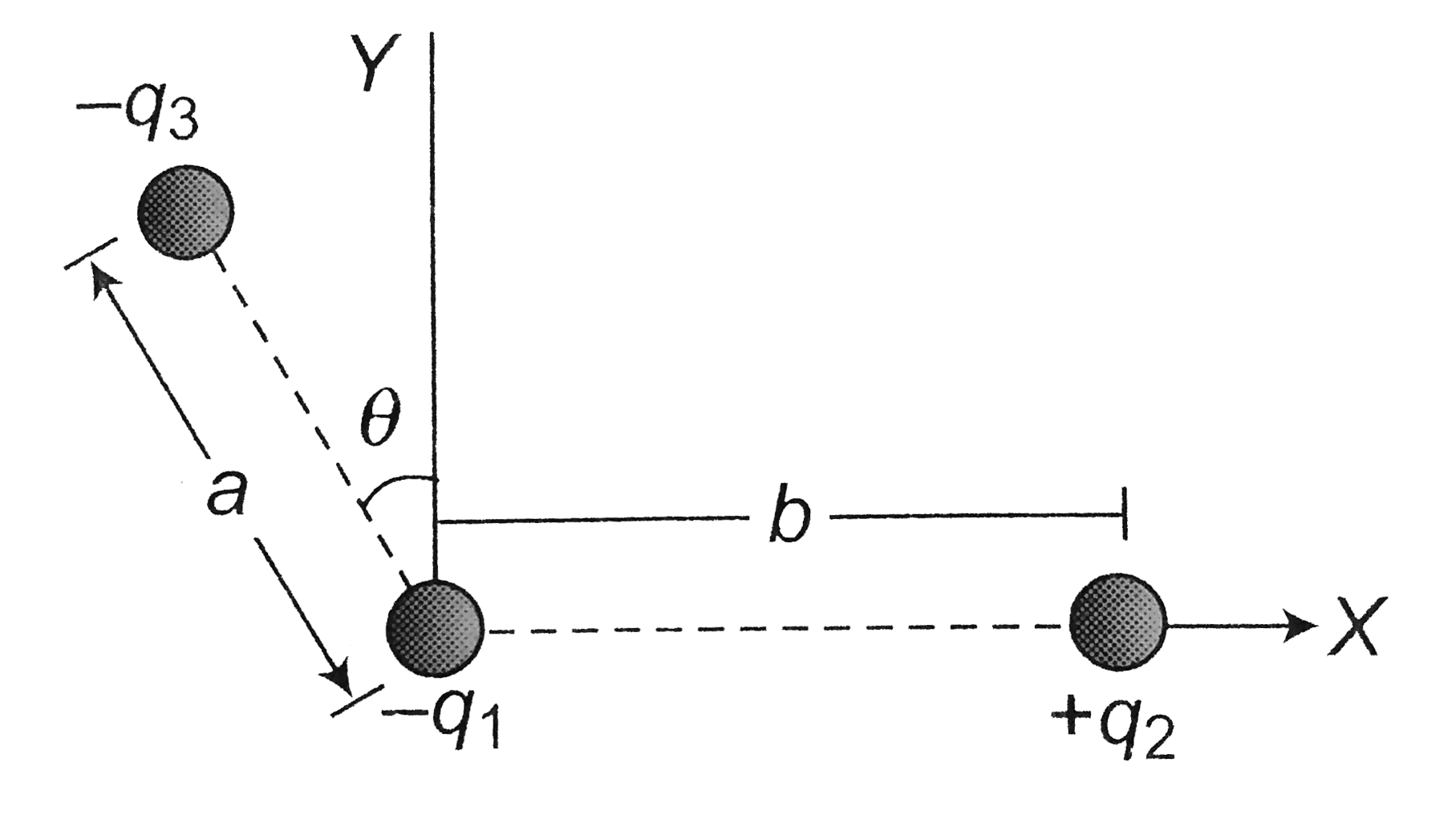Three charges are placed as shown in fig. the magnitude of q1 is 2.00μC, but its sign is unknown. Value of charge q2 is unknown and the value of the charge q3 is +4.00μC, and the net force on q3 is entirely in the negative x-direction

As per the condition given in the problem, the sign of q1 and q2 will be
25.25N
32.5N
56.25N
13.5N
The correct Answer is:C
The four possibel force diagrame are shown in fig. Only the last pocture can result in an electric field the negative x-direction
q1=−2.00(μ)C,q2=+4.00(μ)C,andq2>0

Ey=0=14πε0q1(0.0400m)2sinθ−14πε0q2(0.0300m)2cosθ
q2=916sinθcosθ=916q13/54/5=2764q1=0.843μC
F3=q3Ex=q314πε0(q10.001645+q20.000935)=56.25N.
Topper's Solved these Questions
- BOOK - CENGAGE PHYSICS ENGLISHCHAPTER - COULOMB LAW AND ELECTRIC FIELDEXERCISE - Integer8videos
COULOMB LAW AND ELECTRIC FIELD
- BOOK - CENGAGE PHYSICS ENGLISHCHAPTER - COULOMB LAW AND ELECTRIC FIELDEXERCISE - Single Correct Ansewr Type20videos
COULOMB LAW AND ELECTRIC FIELD
- BOOK - CENGAGE PHYSICS ENGLISHCHAPTER - COULOMB LAW AND ELECTRIC FIELDEXERCISE - Multiple Correct8videos
COULOMB LAW AND ELECTRIC FIELD
- BOOK - CENGAGE PHYSICS ENGLISHCHAPTER - CENGAGE PHYSICS DPPEXERCISE - subjective type51videos
CENGAGE PHYSICS DPP
- BOOK - CENGAGE PHYSICS ENGLISHCHAPTER - ELECTRIC CURRENT & CIRCUITSEXERCISE - Kirchhoff s law and simple circuits15videos
ELECTRIC CURRENT & CIRCUITS
Similar Questions
Three charges are placed as shown in fig. the magnitude of q1 is 2.00μC, but its sign and the value of the charge q3 is +4.00μC, and the net force on q3 is entirely in the negative x-direction

As per the condition given in the problem, the value of q2 will beView SolutionA positive point charge q1 is placed at (a,0) and another positive point charge q2 is placed at (0,a) . Find the force acting on q1.
View SolutionThree charges −q1,+q2 and −q3 are placed as shown in the figure. The x-component of the force on −q1 is proportional to
 View Solution
View SolutionA charge q1 exerts some force on a second charge q2 If a third charge q3 is brought near q2, then the force exterted by q1 on q2
View SolutionThree charges -q,+2q, and -q are arranged on a line as shown in fig. Calculate the field at a distance r>>a on the line.
 View Solution
View SolutionPoint charge are placed at the verticas of a squre of side a as shown in fig. What should be the sign of charge q and magnitude of the ratio |q/Q| so that
(i) net force on each Q is zero?
(ii) net force on each q is zero?
Is it possible that the entire system could be in electrostatic equilibrium?
 View Solution
View SolutionFind the force on a charge q1(=20μC) due to the charge of q2(=10μC) if the positions of the charges are given as P1(1,−1,2) and Q(−1,1,1)
View SolutionThree charges q1=1μC,q2=−2μC and q3=3μC are placed on the vertices of an equilateral triangle of side 1.0 m. find the net electric force acting on charge q1.
How to proceed Charge q2 will attract charge q1 (along the line joining them) and charge q3 will repel charge q1. Therefore, two forces will act on q1, one due to q2 and another due to q3. Since , the force is a vector quantity both of these force (say F1 and F2) will be added by vector method. Following are two methods of their addition
 View Solution
View SolutionIn figure two positive charges q2 and q3 fixed along the y-axis, exert a net electric force in the +x direction on a charge q1 fixed along the x-axis if a positive charge Q is added at (x,0) the force on q1
 View Solution
View SolutionIn figure two positive charges q2 and q3 fixed along the y-axis ,exert a net electric force in the +x direction on a charge q1 fixed along the x-axis if a positive charge Q is added at (x,0) the force on q1
 View Solution
View Solution
